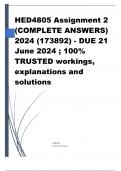HED4805 Assignment 2
(COMPLETE ANSWERS)
2024 (173892) - DUE 21
June 2024 ; 100%
TRUSTED workings,
explanations and
solutions
ADMIN
[COMPANY NAME]
, Question 1 (25) Section A of this question is based on the given extract from
chapter 2 of the prescribed textbook (Seroto, Davids & Wolhuter 2020). Read
the extract, and then answer the questions that follow. Geographical focus of
research and of authorship Scholars, analysts, progressive scholars and
academics in all education sciences and beyond, have expressed concern
that the corpus of scholarly publications is dominated by researchers
Assignment 02 History of Education Due date: 21 June 2024 Unique
assignment number: 173892 100 marks 20 in the global world and that their
focus is lopsided in favour of the Global North or themes favoured by the
interests of the Global North. In a content analysis of articles published in the
first 50 years of the top journal in the field of Comparative and International
Education, the Comparative Education Review, Wolhuter (2008:330-331)
found that countries of the Global North dominate the geographical focus of
research. In addition, where countries of the Global South are the subject of
research, it is dominated by researchers from the Global North (cf Wolhuter,
2018). Of the 18 523 articles published in the total pool of Thomson-Reuters
indexed education journals for the year 2012, a mere 2.13% were authored by
scholars in Africa (ibid). Depaepe and Simon (1996) do not include the
geographical terrain of articles in their research but do provide an interesting
analysis of author provenance. For the articles published during 1961 to 1989
in Paedagogica Historica, the rank-order of national provenance of authors is
illustrated in table 2.2. The pattern for the period 1990 to 1995 does not differ
much. However, in this period, the Global South fares worse with 1.6% of all
authors (South Africa: 0.8% and Zaire: 0.8%) as shown in table 2.3. Table 2.2
National provenance of authors published in rank order, 1961 to 1989
National provenance of authors (Global North) 1961 to 1989 1. Germany:
22.7%; 2. US: 21.5%; 3. UK: 10.6%; 4. France: 7.4%; 5. Belgium: 6.5%
National provenance of authors (Global South) 1961 to 1989 1. India: 1.2%; 2.
Malaysia: 1.2%; 3. Nigeria: 0.6%; 4. Sri Lanka: 0.6%; 5. Argentina: 0.3%; 6.
Oman: 0.3%; 7. Pakistan: 0.3%; 8. South Africa: 0.3%; 9. Thailand: 0.3%; 10.
Zimbabwe: 0.3% (Source: Depaepe & Simon, 1996:426) Table 2.3 National
provenance of authors published in rank order, 1990 to 1995 National
provenance of authors (Global North) 1990 to 1995 1. Netherlands: 20.2%; 2.
Germany: 17.8%; 3. Belgium: 14.0%; 4. France: 10.1%; 5. US: 7.0% National
provenance of authors (Global South) 1990 to 1995 1. Only 1.6% of all
authors in the Global South; 2. South Africa: 0.8%; 3. Former Zaire: 0.8%
(Source: Depaepe & Simon, 1996) Freeman and Kirke (2017) deal with
geographical foci in their analysis, although the limitation of their study is that




